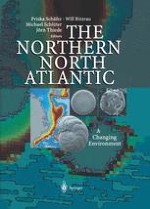2001 | OriginalPaper | Buchkapitel
Particle Flux Variability in the Polar and Atlantic Biogeochemical Provinces of the Nordic Seas
verfasst von : Rolf Peinert, Avan Antia, Eduard Bauerfeind, Bodo V. Bodungen, Olaf Haupt, Marita Krumbholz, Ilka Peeken, René O. Ramseier, Maren Voss, Bernt Zeitzschel
Erschienen in: The Northern North Atlantic
Verlag: Springer Berlin Heidelberg
Enthalten in: Professional Book Archive
Aktivieren Sie unsere intelligente Suche, um passende Fachinhalte oder Patente zu finden.
Wählen Sie Textabschnitte aus um mit Künstlicher Intelligenz passenden Patente zu finden. powered by
Markieren Sie Textabschnitte, um KI-gestützt weitere passende Inhalte zu finden. powered by
A decade of particle flux measurements providse the basis for a comparison of the eastern and western province s of the Nordic Seas. Ice-related physical and biological seasonality as well as pelagic settings jointly control fluxes in the western Polar Province which receive s southward flowing water of Polar origin. Sediment trap data from this realm highlight a predominantly physical flux control which leads to exports of siliceous particle s within the biological marginal ice zone as a prominent contributor. In the northward flowing waters of the eastern Atlanti c Province, feeding strategies, life histories and the succession ofdominant mesozooplankters (copepods and pteropods) are central in controlling fluxes. Furthermore, more calcareous matter is exported here with a shift in flux seasonality towards summer I autumn. Dominant pelagic processes modeled numerically as to their impact on annual organic carbon exports for both provinces confirm that interannual flux variability is related to changes in the respecti ve control mechanisms.Annual organic carbon export s are strikingly similar in the Polar and Atlantic Province s (2.4 and 2.9 g m−2 y−l at 500 m depth), despite major differences in flux control. The Polar and Atlantic Provinces, however, can be distinguished according to annual fluxes of opal (1.4 and 0.6 g m−2 y−l) and carbonate (6.8 and 10.4 g m−2 y−l). Interannual variability may blur this in single years. Thus, it is vital to use multi-annual data sets when including particle exports in general biogeochemical province descriptions. Vertical flux profiles (collections from 500 m, 1000 m in both provinces and 300-600 m above the seafloor deviate from the general vertical decline of fluxes due to particle degradation during sinking. At depths> 1000 m secondary fluxes (laterally advectedlresuspended particles) are often juxtaposed to primary (pelagic) fluxes, a pattern which is most prominent in the Atlantic Province.Spatial variability within the Atlantic Province remains poorly understood, and the same holds true for interannual variability. No proxies are at hand for this province to quantitatively relate fluxes to physical or biological pelagic properties. For the seasonally ice-covered Polar Province a robust relationship exists between particle export and ambient ice-regime (Ramseier et al. this volume; Ramseier et al. 1999). Spatial flux patterns may be differentiated and interannual variability can be analyzed in this manner to impro ve our ability to couple pelagic export patterns with benthic and geochemical sedimentary processes in seasonally ice-covered seas.
